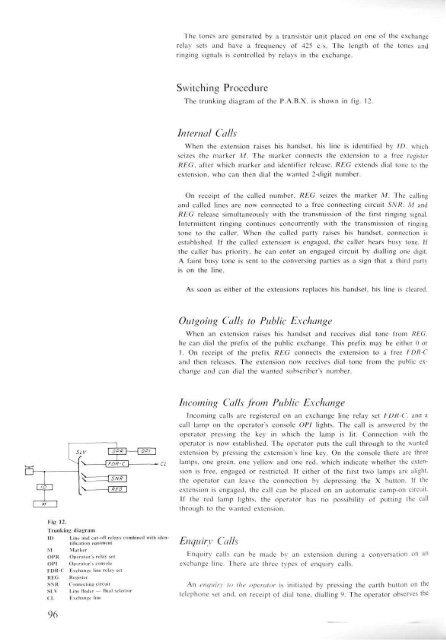1 - ericssonhistory.com
1 - ericssonhistory.com
1 - ericssonhistory.com
You also want an ePaper? Increase the reach of your titles
YUMPU automatically turns print PDFs into web optimized ePapers that Google loves.
The tones are generated by a transistor unit placed on one of the exchange<br />
relay sets and have a frequency of 425 c/s. The length of the tones and<br />
ringing signals is controlled by relays in the exchange.<br />
Switching Procedure<br />
The trunking diagram of the P.A.B.X. is shown in fig. 12.<br />
Internal Calls<br />
When the extension raises his handset, his line is identified by ID, which<br />
seizes the marker M. The marker connects the extension to a free register<br />
REG, after which marker and identifier release. REG extends dial tone to the<br />
extension, who can then dial the wanted 2-digit number.<br />
On receipt of the called number, REG seizes the marker M. The calling<br />
and called lines are now connected to a free connecting circuit SNR. M and<br />
REG release simultaneously with the transmission of the first ringing signal.<br />
Intermittent ringing continues concurrently with the transmission of ringing<br />
tone to the caller. When the called party raises his handset, connection is<br />
established. If the called extension is engaged, the caller hears busy tone. If<br />
the caller has priority, he can enter an engaged circuit by dialling one digit.<br />
A faint busy tone is sent to the conversing parties as a sign that a third party<br />
is on the line.<br />
As soon as either of the extensions replaces his handset, his line is cleared.<br />
Outgoing Calls to Public Exchange<br />
When an extension raises his handset and receives dial tone from REG,<br />
he can dial the prefix of the public exchange. This prefix may be either 0 or<br />
1. On receipt of the prefix REG connects the extension to a free FDR-C<br />
and then releases. The extension now receives dial tone from the public exchange<br />
and can dial the wanted subscriber's number.<br />
In<strong>com</strong>ing Calls from Public Exchange<br />
In<strong>com</strong>ing calls are registered on an exchange line relay set t'DR-C, ana a<br />
call lamp on the operator's console OPI lights. The call is answered by the<br />
operator pressing the key in which the lamp is lit. Connection with the<br />
operator is now established. The operator puts the call through to the wanted<br />
extension by pressing the extension's line key. On the console there are three<br />
lamps, one green, one yellow and one red, which indicate whether the extension<br />
is free, engaged or restricted. If either of the first two lamps are alight,<br />
the operator can leave the connection by depressing the X button. If the<br />
extension is engaged, the call can be placed on an automatic camp-on circuit.<br />
If the red lamp lights, the operator has no possibility of putting the call<br />
through to the wanted extension.<br />
Enquiry Calls<br />
Enquiry calls can be made by an extension during a conversation on an<br />
exchange line. There are three types of enquiry calls.<br />
An enquiry to the operator is initiated by pressing the earth button on the<br />
telephone set and, on receipt of dial tone, dialling 9. The operator observes the
















